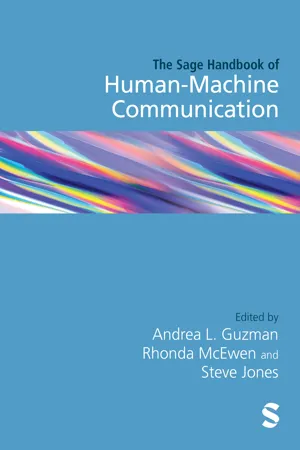
The SAGE Handbook of Human–Machine Communication
- 640 pages
- English
- ePUB (mobile friendly)
- Available on iOS & Android
The SAGE Handbook of Human–Machine Communication
About this book
The SAGE Handbook of Human-Machine Communication has been designed to serve as the touchstone text for researchers and scholars engaging in new research in this fast-developing field. Chapters provide a comprehensive grounding of the history, methods, debates and theories that contribute to the study of human-machine communication. Further to this, the Handbook provides a point of departure for theorizing interactions between people and technologies that are functioning in the role of communicators, and for considering the theoretical and methodological implications of machines performing traditionally 'human' roles. This makes the Handbook the first of its kind, and a valuable resource for students and scholars across areas such as communication, media and information studies, and computer science, as well as for practitioners, engineers and researchers interested in the foundational elements of this emerging field.
Part 1: Histories and Trajectories
Part 2: Approaches and Methods
Part 3: Concepts and Contexts
Part 4: Technologies and Applications
Frequently asked questions
- Essential is ideal for learners and professionals who enjoy exploring a wide range of subjects. Access the Essential Library with 800,000+ trusted titles and best-sellers across business, personal growth, and the humanities. Includes unlimited reading time and Standard Read Aloud voice.
- Complete: Perfect for advanced learners and researchers needing full, unrestricted access. Unlock 1.4M+ books across hundreds of subjects, including academic and specialized titles. The Complete Plan also includes advanced features like Premium Read Aloud and Research Assistant.
Please note we cannot support devices running on iOS 13 and Android 7 or earlier. Learn more about using the app.
Information
Table of contents
- Cover
- Half Title
- Title Page
- Copyright Page
- Dedication
- Contents
- Notes on the Editors and Contributors
- Human–Machine Communication, Humacomm, and Origins: A Foreword by Steve Mann, 2022
- Acknowledgements
- Introduction to the Handbook
- Part 1 Histories and Trajectories
- 1 Machines are Us: An Excursion in the History of HMC
- 2 The Interdisciplinarity of HMC: Rethinking Communication, Media, and Agency
- 3 Cybernetics and Information Theory in Human–Machine Communication
- 4 Cyborgs and Human–Machine Communication Configurations
- 5 The Meaning and Agency of Twenty-First-Century AI
- 6 The History and Future of Human–Robot Communication
- 7 From CASA to TIME: Machine as a Source of Media Effects
- 8 Computer-Supported Cooperative Work (CSCW) and Human–Machine Communication (HMC)
- 9 HMC and HCI: Cognates on a Journey
- 10 Developing a Theory of Artificial Minds (ToAM) to Facilitate Meaningful Human–AI Communication
- 11 HMC and Theories of Human–Technology Relations
- 12 Philosophical Contexts and Consequences of Human–Machine Communication
- 13 Critical and Cultural Approaches to Human–Machine Communication
- 14 Gender and Identity in Human–Machine Communication
- 15 Literature and HMC: Poetry and/as the Machine
- 16 Human–Machine Communities: How Online Computer Games Model the Future
- 17 Perfect Incommunicability: War and the Strategic Paradox of Human–Machine Communication
- Part 2 Approaches and Methods
- 18 Human–Robot Interaction
- 19 Auditing Human–Machine Communication Systems Using Simulated Humans
- 20 Experiments in Human–Machine Communication Research
- 21 Detecting the States of Our Minds: Developments in Physiological and Cognitive Measures
- 22 Human Shoppers, AI Cashiers, and Cloud-computing Others: Methodological Approaches for Machine Surveillance in Commercial Retail Environments
- 23 Visual Research Methods in Human–Machine Communications
- 24 Observing Communication with Machines
- 25 Coding Ethnography: Human–Machine Communication in Collaborative Software Development
- 26 An Ethnography for Studying HMC: What Can We Learn from Observing How Humans Communicate with Machines?
- 27 Talking about “Talking with Machines”: Interview as Method within HMC
- 28 Feminist, Postcolonial, and Crip Approaches to Human–Machine Communication Methodology
- 29 A Research Ethics for Human–Machine Communication: A First Sketch
- Part 3 Concepts and Contexts
- 30 Rethinking Affordances for Human–Machine Communication Research
- 31 Affect Research in Human–Machine Communication: The Case of Social Robots
- 32 Social Presence in Human–Machine Communication
- 33 Interpersonal Interactions Between People and Machines
- 34 Dual-Process Theory in Human–Machine Communication
- 35 Privacy and Human–Machine Communication
- 36 Natural Language Processing
- 37 Datafication in Human–Machine Communication Between Representation and Preferences: An Experiment of Non-binary Gender Representation in Voice-controlled Assistants
- 38 Human–Machine Communication and the Domestication Approach
- 39 Intersectionality and Human–Machine Communication
- 40 Human–Machine Communication, Artificial Intelligence, and Issues of Data Colonialism
- 41 A Feminist Human–Machine Communication Framework: Collectivizing by Design for Inclusive Work Futures
- Acknowledgements
- 42 Dishuman–Machine Communication: Disability Imperatives for Reimagining Norms in Emerging Technology
- Acknowledgements
- 43 Robotic Art – The Aesthetics of Machine Communication
- 44 Labor, Automation, and Human–Machine Communication
- Acknowledgements
- 45 The Brain Center Beneath the Interface: Grounding HMC in Infrastructure, Information, and Labor
- 46 AI, Human–Machine Communication and Deception
- 47 Governing the Social Dimensions of Collaborative Robotic Design: Influence, Manipulation, and Other Non-Physical Harms
- 48 Who's Liable?: Agency and Accountability in Human–Machine Communication
- 49 The Popular Cultural Origin of Communicating Robots in Japan
- Part 4 Technologies and Applications
- 50 Human Social Relationships with Robots
- 51 Algorithms as a Form of Human–Machine Communication
- 52 Bot-to-Bot Communication: Relationships, Infrastructure, and Identity
- 53 Communicating with Conversational Assistants: Uses, Contexts, and Effects
- 54 Conceptualizing Empathic Child–Robot Communication
- 55 Haptics, Human Augmentics, and Human–Machine Communication
- 56 HMC in Love, Sex and Robots
- 57 Virtual Reality as Human–Machine Communication
- 58 HMC in the Educational Context
- 59 Human–Machine Communication in Healthcare
- 60 Why Human–Machine Communication Matters for the Study of Artificial Intelligence in Journalism
- 61 Human–Machine Communication in Marketing and Advertising
- 62 Human–Machine Communication in Retail
- 63 Autonomous Vehicles: Where Automation Ends and the Communication Begins
- 64 HMC in Space Operations
- 65 Religious Human–Machine Communication: Practices, Power, and Prospects
- Index